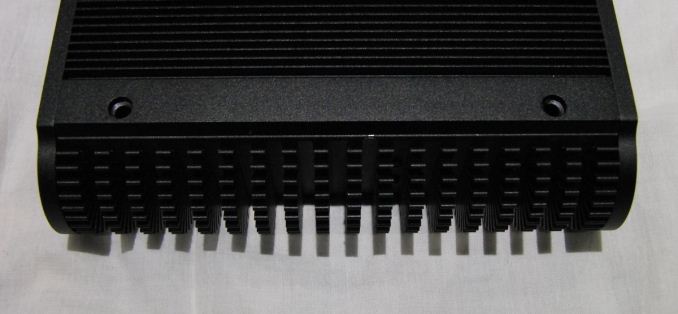HABEY BIS-6922 Fanless Ivy Bridge Industrial PC Review
by Ganesh T S on August 13, 2013 9:00 AM EST- Posted in
- Industrial PC
- Ivy Bridge
- Passive Cooling
- Habey
Motherboard Features & Thermal Design
The unique nature of the BIS-6922 is evident in the chassis design. While other fanless PCs such as the Aleutia Relia go in for a rectangular design with hard edges and fins to blend in with it, the Habey fanless unit opts for a curved design on either side. The chassis is made to act as a heat sink and the circular metal segments on either side are serrated. This gives more surface area for heat to dissipate compared to the rectangular fins found in other fanless configurations. Habey terms this 'ICE-FIN'. It also delivers a distinctive look to the unit.
The BIS-6922 has no ventilation holes. Even the power button in the front panel is protected by a sealed plastic cap on the rear side of the front panel. This makes the unit almost fully dust-proof. Despite the dust-proof nature, the unit is very easy to take apart. The underside panel is held by only one screw, It provides access to a mini-PCIe and SIM card slot (for 3G / 4G data connectivity).
The ridged top panel can be easily removed to reveal the heat dissipation mechanism. The 2.5" disk drive is mounted on the underside of this top panel. The top panel has a groove on each side which lines up with similar grooves on the sides of the chassis. We have liberal thermal paste applied to copper heat pipes that are placed in the grooves to improve the thermal conductivity between the chassis sides and the top panel.
After disconnecting the SSD wires from the motherboard, it is possible to completely remove the top panel from the main chassis. This enables us to get a better view of the thermal solution and also some interesting motherboard features. These include PCIe / PCI lanes brought out to the edge of the motherboard (which is unfortunately not usable with the BIS-6922's chassis configuration) and an additional mPCIe slot for a Wi-Fi/BT card or mPCIe SSD. An mSATA port is also available. One of the two SODIMM memory modules (Super Talent / DDR3-1333) is also visible (The other one is partially visible after removing the panel on the bottom).
The motherboard is based on the QM77 chipset. This provides various features targeting business, embedded and industrial PC applications including Intel AMT and support for vPro processors amongst other features.
The CPU and PCH are placed on the motherboard in such a way that a single rectangular block of metal covers both of them. The block has two grooves out of which copper heat pipes swathed in thermal paste emerge to make contact with the inner sides of the chassis (one heat pipe to each side). The contact of these heat pipes with the sides is firmed up thanks to another set of smaller metal blocks. Compared to the heat pipes with a liberal number of bends in the Aleutia Relia, the thermal design configuration of the BIS-6922 is very simple and straightforward. Does this design lead to better thermal performance? Before finding that out, let us take a look at the performance numbers and power consumption of the unit.





















63 Comments
View All Comments
garadante - Tuesday, August 13, 2013 - link
With the system running that hot, I would've liked to have seen temperatures for the other components, notable the SSD. I don't think SSDs are designed to run as hot and as long as CPUs/GPUs are. Same with the RAM.airmantharp - Tuesday, August 13, 2013 - link
That'd definitely be nice, but I don't think it'd be much of a problem; RAM has a high thermal tolerance these days, and the SSD is pretty far away. I'd be much more worried about an mSATA drive and WiFi mPCIe card, though, and I'm kind of puzzled why those options weren't explored.garadante - Wednesday, August 14, 2013 - link
Well looking at the external temperatures of the case, it looks like some areas are hitting 70 degrees Celsius, which is above the working temperature for many SSDs I believe, which are rated for 60 degrees. generally? But not to mention every component in there is likely baking at around 70 C, I'd like to see an analysis on the actual temperatures inside there and the impact this would have on longevity.OCedHrt - Tuesday, August 13, 2013 - link
Still waiting for one with eSATA output. Seriously.ganeshts - Tuesday, August 13, 2013 - link
Pretty sure Habey would be ready to do a custom back panel for you if it is required in volume (for a price, of course). There are plenty of spare SATA ports on the motherboard.airmantharp - Tuesday, August 13, 2013 - link
He could just cut a hole for one or two- where's your Dremel and sense of adventure?!?JimmiG - Wednesday, August 14, 2013 - link
Would be interesting to see what could be done with an ATX-sized case acting as a heatsink. There would be a *lot* of surface area to dissipate the heat..cjs150 - Wednesday, August 14, 2013 - link
Zalman did one a few years back. Very heavy and expensive but workedganeshts - Wednesday, August 14, 2013 - link
You can take a look at our Streacom FC10 review (linked in the article). It performs well and obviously better than this one because of its size.Heartdisease - Wednesday, August 14, 2013 - link
It sounds like this would be a perfect unit to put in a car behind the dash as a media hub for the Kiddo's. How is therice compared to a do it yourself non dust proof box?